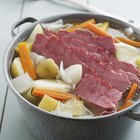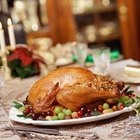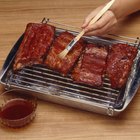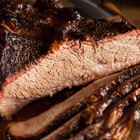
Not much ruins a meal like drying out the meat during baking. Whether you're preparing beef, pork, venison, veal, poultry, seafood or some other type of meat, the high heat during cooking causes water to seep out of muscle fibers. As it moves to the surface, it evaporates, leaving the food a little bit drier and tougher. When you're baking -- a dry-heat cooking method -- the longer the meat's in the oven, the drier it becomes. Cook the food no longer than needed to make it safe for consumption, and adopt a few other strategies to achieve tender, moist meat.
Step 1
Bring cuts of meat by soaking them in water mixed with 1/3 cup of kosher salt per 4 cups of liquid. Brining passes extra moisture into meat so it doesn't dry out as much during baking. For more flavor, replace some or all of the water with beer, wine, soy sauce, broth, fruit juice, vinegar or other suitable liquid. Mix in complementary spices, herbs and sweetener. Brine seafood in the refrigerator for 10 to 30 minutes; small cuts of meat for up to a few hours; and large roasts and whole birds for six to 24 hours.
Step 2
In the oven, cover the baking tray or dish with aluminum foil during cooking. This steams the food in its own juices and keeps it juicier. Because this method interferes with browning and crisping, cover the dish only if you're willing to sacrifice these aspects for moister meat.
Step 3
Monitor food closely in the oven and read its internal temperature with a meat thermometer. Cook solid cuts of red meat to 145 degrees Fahrenheit, poultry and ground meats to 165 F and seafood just until its flesh is opaque all the way through.
Step 4
Remove very small cuts of meat from the oven when they're 3 degrees below their target internal temperature. Take out hefty steaks and similarly sized cuts of meat when they're 5 degrees below the target. Remove large roasts and whole birds when they're about 10 degrees shy of the final desired temperature. The temperatures rise the rest of the way during resting. If you take meat out when it's cooked all the way to its target temperature, it overcooks slightly by the time you eat it.
Step 5
Rest smaller cuts of meat for about 10 minutes, and larger roasts and whole birds for at least 15 minutes. Tent the food loosely with aluminum foil if you're concerned about it cooling too much. Don't rest food on the baking tray or in the dish you cooked it in, as it is hot enough to continue cooking the food rapidly. Rest it on a plate, cutting board or serving platter, where the meat's muscle fibers have the chance to reabsorb juices so they remain in the meat when you cut it.
Related Articles

Shank Ham Cooking Directions
How to Cook Sirloin Filets in a Pan and ...

How to Soak Deer Meat in Baking Soda

The Best Way to Smoke Yellowtail

How to Make a Water Bath for Baking

How to Cook Beef Shoulder Muscle

How to Sear Tenderloin Steak and Cook ...

How to Cook a Large Amount of Corned ...
How Long to Bake Swordfish Steaks

Seasonings for a Turkey Breast

How Long Can You Cook Beef Ribs at 300 ...

How to Cook a Wild Goose in a Slow ...

How to Cook the Neck of a Deer

Can Lamb Chops Be Pink in the Middle?

Difference Between Fryer & Roaster ...

How to Quickly Cook Fork-Tender Ribs

How to Use Wood Chips in a Smoker

How to Cook Pan Fried Deer Tenderloin

How to Steam a Brisket of Beef

If Meat Is Frozen, How Long Does It ...
References
Warnings
- Refrain from basting turkey or other meats during baking. Contrary to popular belief, basting does nothing to impart more moisture or flavor into the food. At most, it helps brown and crisp the skin or outside of the meat a little. Repeatedly opening the oven door lets out considerable heat, too, which extends the cooking time; this in turn leads to drier meat. If you must baste to improve browning and crisping, do so infrequently near the end of the cooking time.
Writer Bio
Eric Mohrman is a food and drink, travel, and lifestyle writer living in Orlando, Florida. He has professional experience to complement his love of cooking and eating, having worked for 10 years both front- and back-of-house in casual and fine dining restaurants. He has written print and web pieces on food and drink topics for Visit Florida, Orlando Style Magazine, CrushBrew Magazine, Agent Magazine, Dollar Stretcher Magazine, The 863 Magazine and other publications.
Photo Credits
Spike Mafford/Photodisc/Getty Images